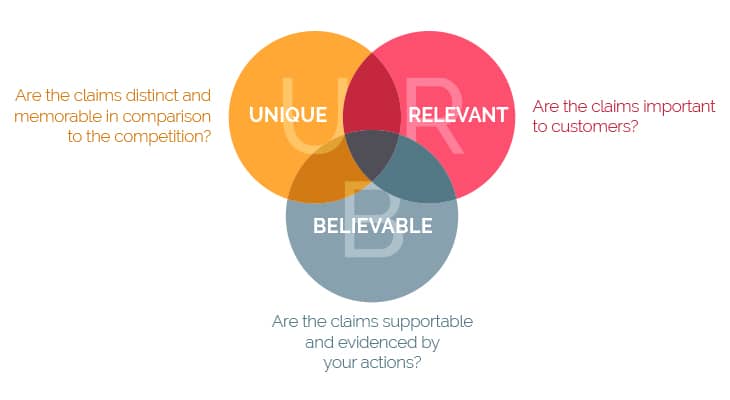Technology marketers must confront the realities of media saturation. Delivering effective messaging means having to stand out not only amongst your competitors, but also from all forms of channel noise. Content has to work harder than ever before.
Check Your U.R.B. Levels
Today’s large organizations are racing to develop fresh, authentic content for their savvy audiences. Whether B2B or B2C, offering useful content to your current and prospective customers affords you a competitive edge over companies that are perceived as less conversational or friendly.
But not just any content will engage readers. To make sure you’re meeting the needs of your audience, check that your content is “U.R.B.” The U.R.B. acronym offers a framework for evaluating messaging at any stage—from nascent ideas to published content needing review. Here’s a description of each of the three components.

Unique: What’s Different About Your Message?
There is no other organization like yours. This is not hyperbole; each company has its own personality, mission and values. And of course, each organization utilizes systems and processes that are at least a little bit different from any other.
So how do you gauge whether your content is unique enough? Clues can often be found in the level of specificity of the message. Let’s look at a company that wants to add a brand value statement to their marketing materials.
We could start by asking what is it about your organization that makes it stand out from competitors.
Let’s say the response was, “Great customer service is what make us unique.”
Sounds good. But lots of companies say they offer great customer service. Can you get more specific?
Okay, how about: “We make sure to respond quickly.”
Yes, that’s more specific – can we dial it in even more?
In this simplified example, the exercise continues until a truly unique sentiment emerges. You might realize that your customer promise—and a top value for senior leadership—really boils down to a fierce commitment to return all phone calls within one hour. Therefore, a new differentiating statement might be, “calls returned within an hour.” Now, the promise this brand is making has gone from vague and commonplace (“great customer service”) to specific and distinct (“calls returned within an hour”). Unique? Check.
Relevant: Why Should They Care?
For maximum impact, successful marketing materials must always answer this question—without it, your audience doesn’t have a reason to pay attention in the first place. Starting with “why should they care” gives you a solid foundation from which to brainstorm. The resulting content will create a contextualized conversation between your organization and the audience.
The misses that occur in content development often result from a lack of this type of context. Your audience may not understand what triggered the communication, or what action they’re supposed to take next. This indicates a failure to communicate relevance—a gap which can be corrected by clarifying topic, benefits and timing.
- Topic – What do I want to communicate explicitly? Implicitly?
Challenge yourself to answer this question as specifically as possible. The main topic of your communication might be obvious, but is there any subtext you want to convey? Having a clear understanding of your topic (and subtext) will help you keep messaging on-target. - Benefits – How do both parties benefit from this communication?
For example, a promotional code can benefit customers by activating discounts, while also giving marketers the ability to track that code. Content is more persuasive when it benefits both sides of the conversation. - Timing – Is there a life stage, seasonal, or other time-related event that would add more “stickiness” to your message? For example, messaging to a customer about to graduate from college would be very different from messaging targeting a retiree.
Armed with a clear vision of the message you want to convey, you can make adjustments to improve relevance. And when marketing communication is relevant, it feels natural—even insightful—to your audience.
Believable: Why Should They Trust You?
Your content will be more compelling if you can include some form of authoritative statement related to your message. Of course, the authoritative statement must also be true. For example, if your organization claims to make a widget that lasts 30 percent longer than any other widget, knowledgeable customers will expect this claim to be documented and verifiable. If they find out otherwise, credibility is lost—along with the sale.
After you’ve reviewed your messaging to make sure that you haven’t made any claims you can’t back up, make sure you’re leveraging all of the claims you can back up. There may be benefits or features you could be better emphasizing.
You should emphasize any awards or accolades that relate to your content, as well as independent research or benchmarking that may yield a proof point for your product or service. But even if you don’t have many of these (yet), there’s a powerful source of messaging authority any company can leverage: the customer testimonial.
Customer testimonials are highly desirable, because they’re highly compelling. Make sure you’ve reached out to any customers who would be willing to be quoted in print (or even better, on camera) promoting your organization. You might be surprised how willing your customers are to lend their support!
Think about your business from end to end and consider how much “proof”—from awards to testimonials—you might be able to gather to strengthen your messaging.
Apply U.R.B. and Connect to Your Audience
The next time your content seems like it’s not hitting the mark, check that what you’re communicating is unique, relevant and believable. Meeting the U.R.B. standard helps you create and deliver content that has real value to your audience—and therefore, real value to you.

